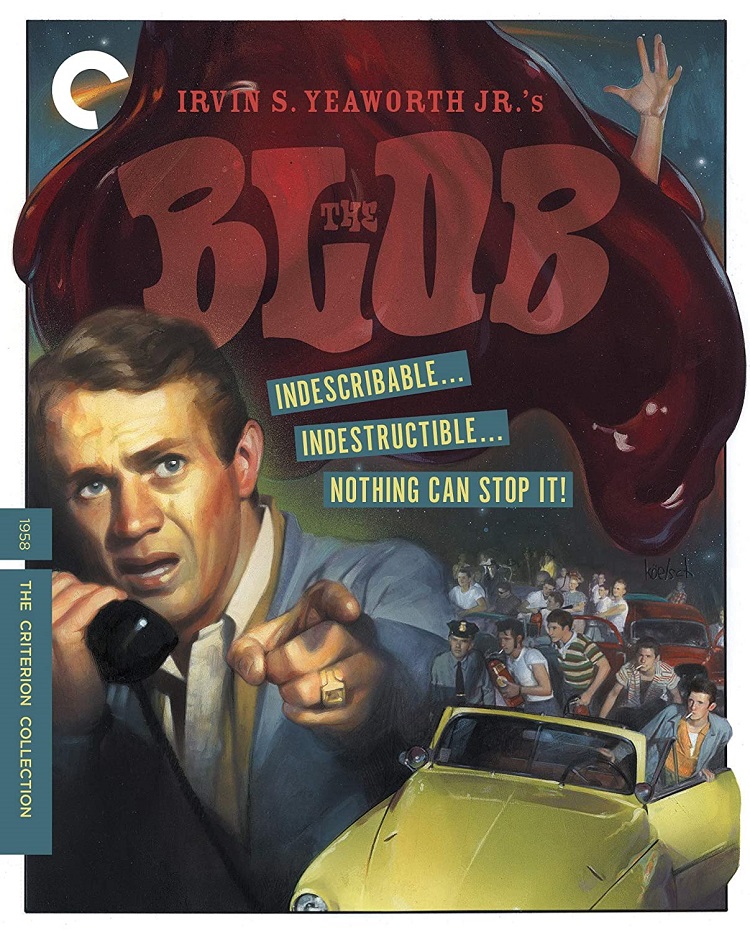
Watching The Blob (1958) and then watching The Blob (1988) reveals much about how American culture changed over three decades. In the ’58 edition, melodramatic overacting ruled the day; movie tickets were 80 cents; women were little more than helpless, whimpering, babbling, hysterical scenery; musical accompaniment is unabashedly schmoozy; teenage shenanigans consisted of racing cars backwards; and getting a stern lecture from the police at worst.
Fast-forward 30 years, and we’ve got screaming tension, movie tickets have quadrupled in price, women have become kick-ass protagonists, the music is piercing and scary, and shenanigans have evolved to jumping motorcycles over chasms and getting into fisticuffs on a regular basis. Oh, and we also went from vague movie monsters whose horror was largely implied to gore-fests where skin melts, limbs break off, and blood flies everywhere. However, the main arc of each is very similar, with largely the same major events portrayed in each, but to unique effect. They’re two very different animals that I appreciate for different reasons.
Tonight, I revisited the 1958 production for the second time in my life; this time in 4k digitally restored high definition with an uncompressed mono soundtrack. While it makes some more of the details in the movie pop, it doesn’t make it look any less, how shall we say, vintage.
The story begins as teenagers Steve (Steve McQueen) and Jane (Aneta Corsaut) have reached the PG stages of their new relationship. Just as they’re talking about the magnificence of shooting stars, a meteorite falls out of the sky and hits the ground not far from their bright blue nest of commingling. They go to investigate, and find an old man (screen icon Olin Howland) who got there ahead of them, now with his hand covered in a seemingly corrosive, gelatinous goop. They rush him to the town doctor for help (not the hospital, mind you…ahh, the quaint ’50s), things go from bad to worse, and before they know it, the entire town is faced with combating a faceless, emotionless, indestructible killing ooze.
Okay, so that’s the first and last 15 minutes of the movie. Where the 1988 remake makes a point of hitting its action and scare beats regularly, 1958 was a simpler time, more focused on dialogue and emotion. It’s not from a lack of special effects (well, not always anyway) and clever presentation that the monster gets less screen time in the original. The gallery of still images and behind-the-scenes footage on the disc gives you a good idea of the props, sets, tools, and camera trickery that went into making an inert ball of slime appear to have a vicious life all its own. They managed to do quite a bit with what they had — it eats a doctor, slides under doorways, drops out of ventilation ducts onto an unsuspecting movie theater crowd, and tries to consume an entire diner.
Two particular sequences in the original that worked well for me are when Steve and Jane are trapped in the cellar of the diner, the entire building encased by the titular beast, and the building catches on fire (retrospectively something of a tip of the hat to McQueen’s fire chief O’Hallorhan 16 years later in The Towering Inferno). All hope seems lost, and the survivors are faced with waiting out the fire and risking smoke inhalation, or death at the touch of the monster. The other sequence isn’t something that was in the film, but rather something that was not in the film — an explanation of the creature’s origin. The whole “biological weapon gone awry” nonsense spoke well (if nonsensically) to the Cold War mentality of the ’80s, but it’s not at all necessary or useful to explain where the thing came from. Maybe not knowing is scarier. I think so, at least.
In addition to the feature and collection of stills from production and international promo posters, the Blu-ray holds the original trailer for the film, as well as two separate commentary tracks from the 2000 Criterion Collection release, one with producer Jack H. Harris and film historian Bruce Eder and the other with director Irvin S. Yeaworth, Jr. and actor Robert Fields. Inside the case is a fold-out essay by critic Kim Newman.
This antagonist shines when compared to the many funny-looking painted rubber suits of the day. The story works well enough, though it does drag a bit by today’s standards, but gives you a glimpse at what horror felt like in a simpler time, where not everything was resolved by the biggest gun. These kids have to think their way out of the problem, and do so admirably enough. The events of the film are also compressed into a single night’s time, giving a greater sense of urgency to the proceedings than you might find in other fright-fests that drag out for days or weeks.
If you’re a fan of the movie, have only seen the remake, or just want to poke your head in on some classic ’50s monster mayhem, 1958’s The Blob has been and remains a solid choice. The Criterion Collection extras just make it that much more worthwhile.